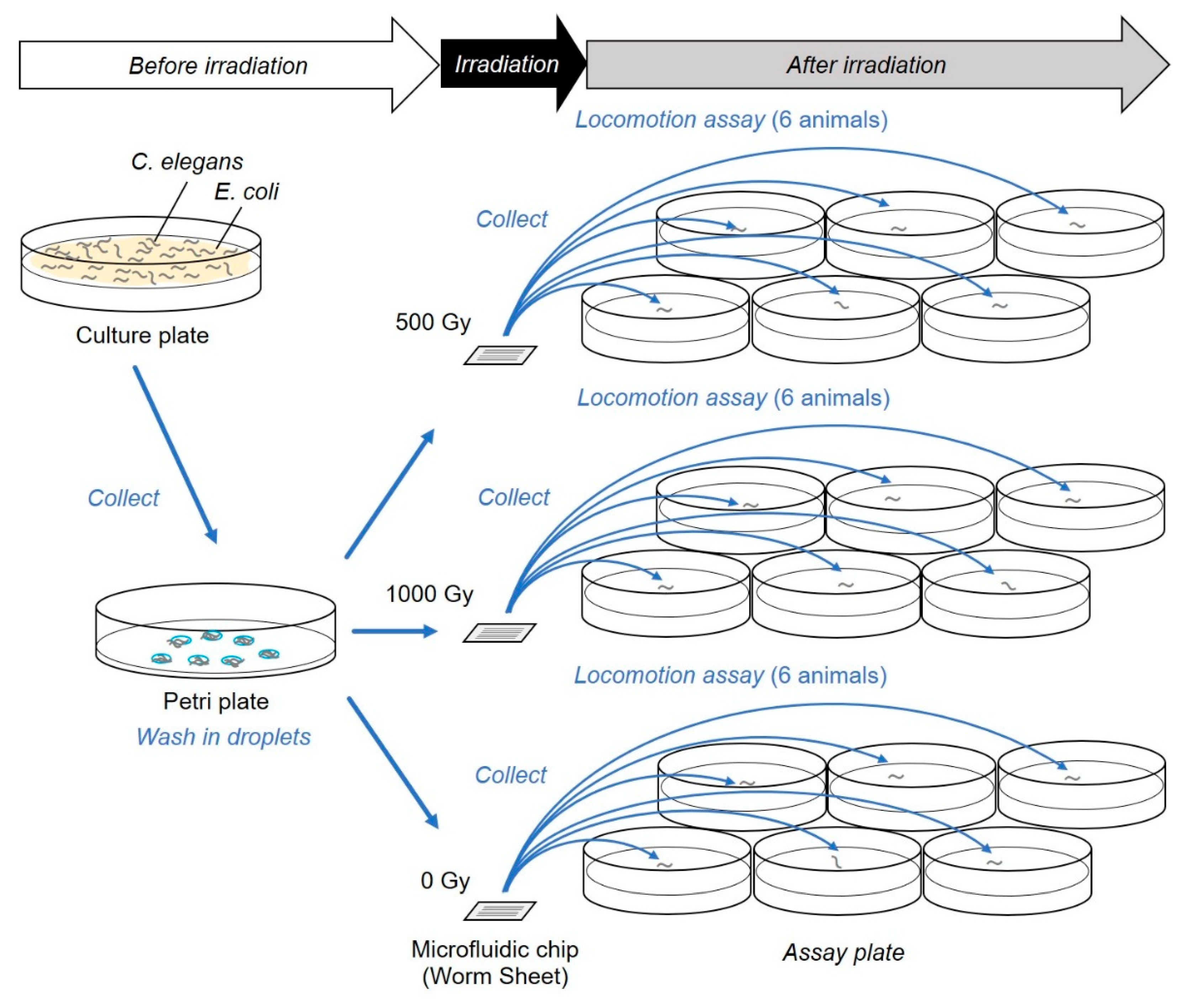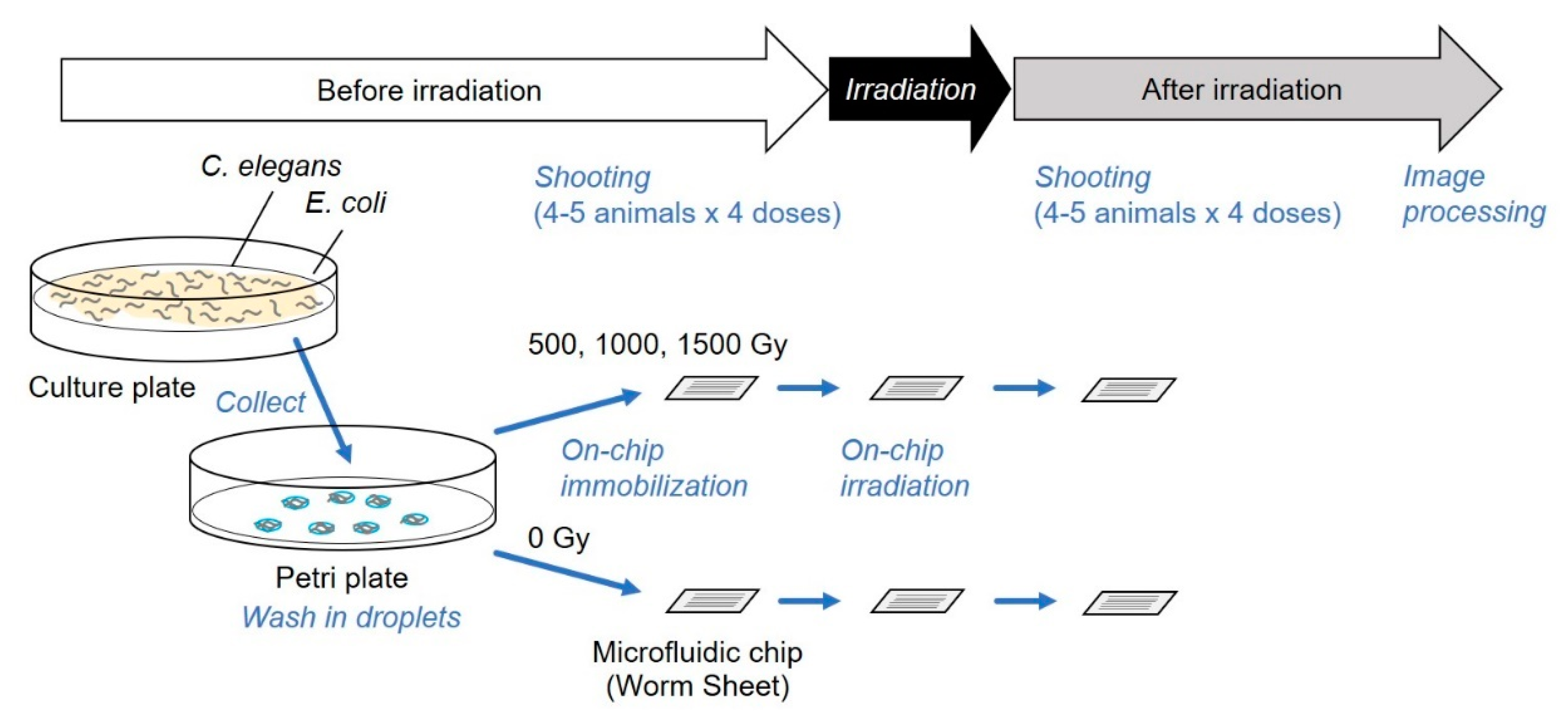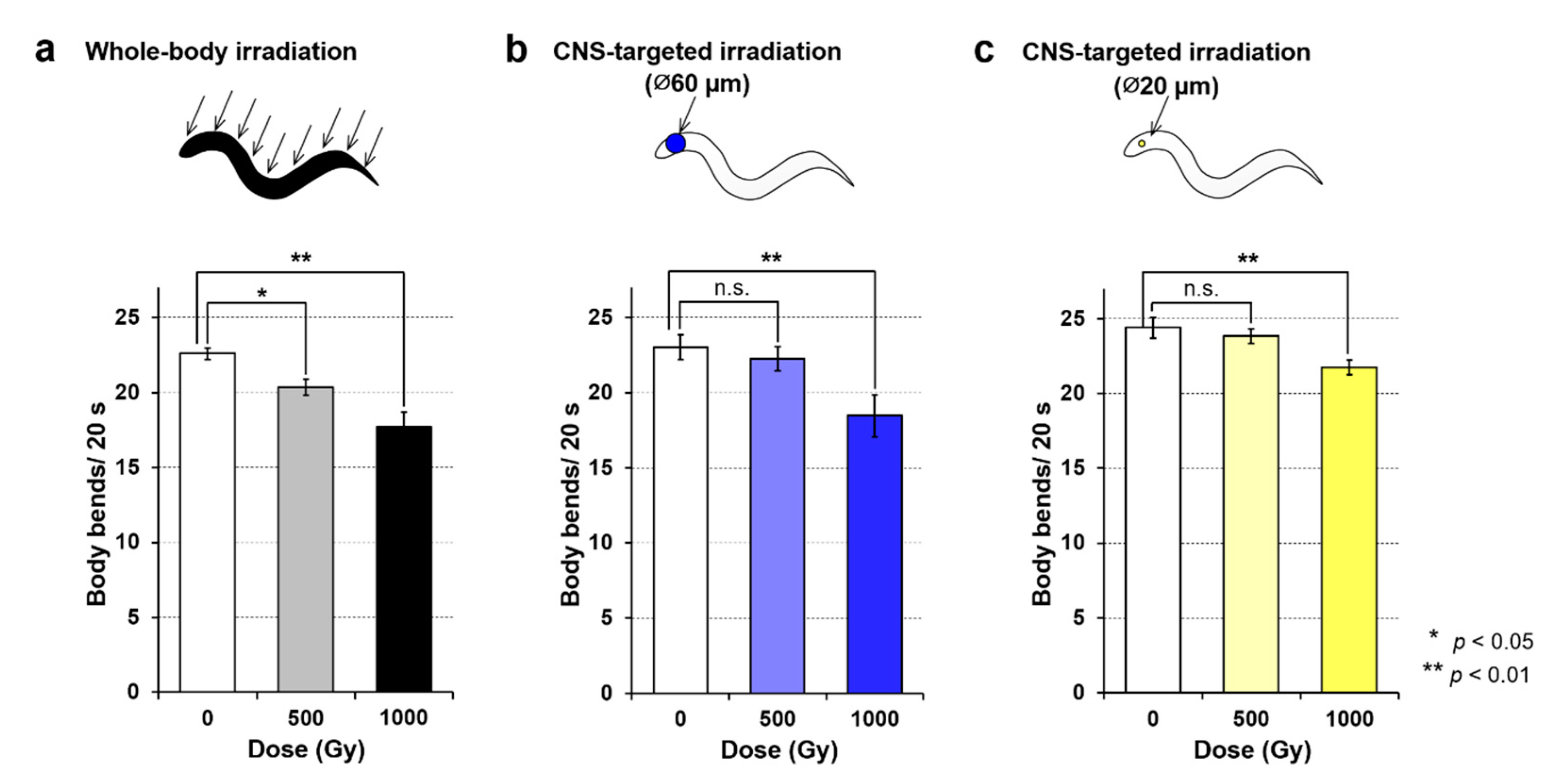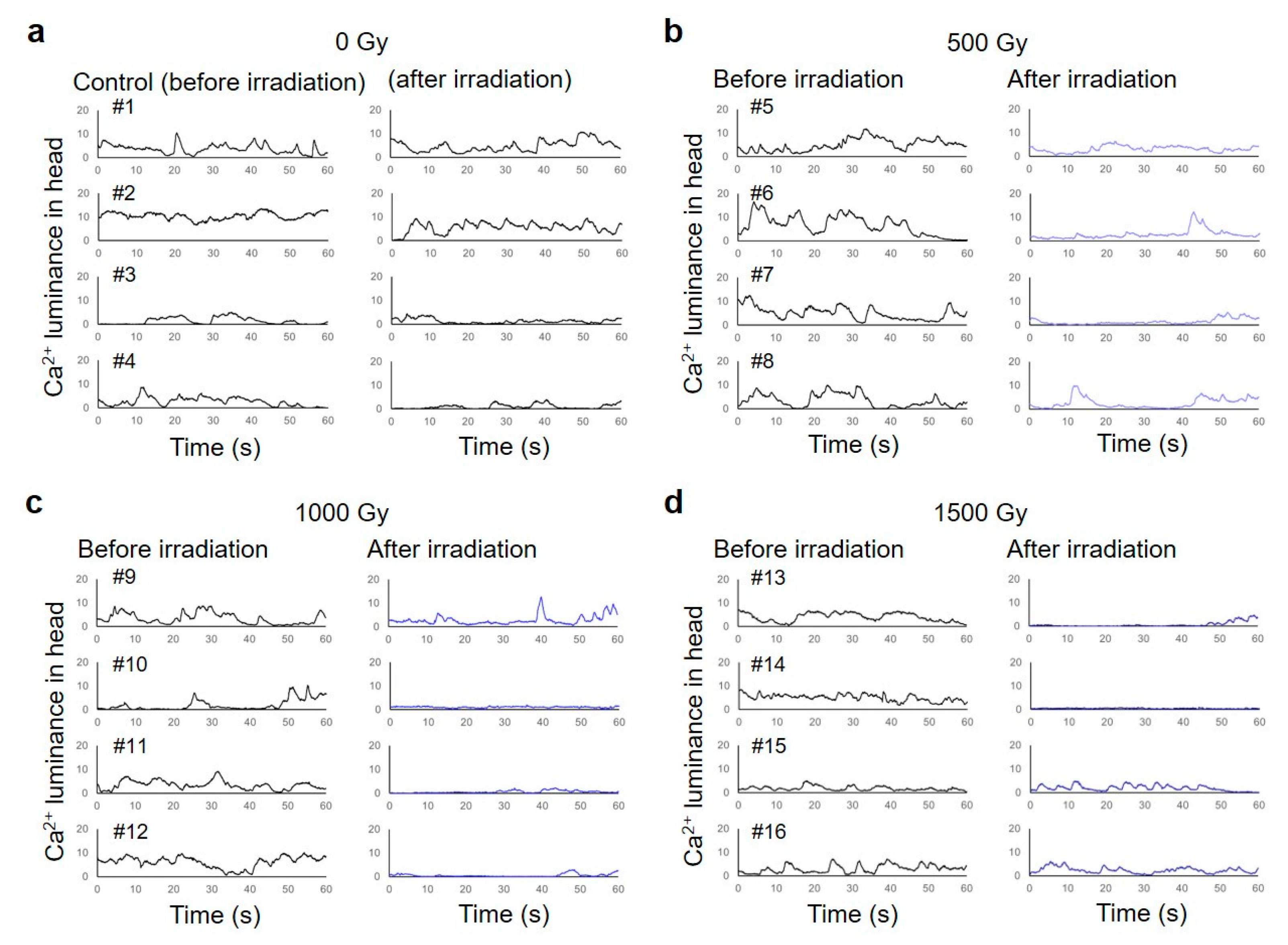Targeted Central Nervous System Irradiation of Caenorhabditis elegans Induces a Limited Effect on Motility
Abstract
:1. Introduction
2. Materials and Methods
2.1. Strains and Culture
2.2. Evaluation of Carbon-Ion Collimation
2.3. Sample Preparation Immediately before Irradiation
2.4. Targeted Microbeam or Whole-Body Broad-Beam Irradiation with High Linear Energy Transfer Carbon Ions
2.5. Locomotion Assay
2.6. Series of Observations and Irradiation on a Microfluidic Chip
3. Results
3.1. CNS-Targeted Irradiation Elicits Dose-Dependent and Irradiated Area-Dependent Effects on Motility
3.2. Effects of Irradiation on Head Muscle Activities of CNS-Irradiated Animals
4. Discussion
4.1. Effectiveness of PDMS Microfluidic Chips in Targeted-Irradiation Experiments
4.2. Effects of Head (CNS)-Targeted Irradiation on Motility Reflect Effects on the CNS and Muscle Cells
4.3. Remaining Issues on the Targeted Irradiation and Analysis of Cell Responses
5. Conclusions
Author Contributions
Funding
Acknowledgments
Conflicts of Interest
References
- Brenner, S. The genetics of Caenorhabditis elegans. Genetics 1974, 77, 71–94. [Google Scholar] [PubMed]
- White, J.G.; Southgate, E.; Thomson, J.N.; Brenner, S. The structure of the nervous system of the nematode Caenorhabditis elegans. Philos. Trans. R. Soc. Lond. B Biol. Sci. 1986, 314, 1–340. [Google Scholar] [PubMed]
- Hall, D.H.; Altun, Z.F. C. elegans Atlas; Cold Spring Harbor Laboratory Press: Ney York, NY, USA, 2007; pp. 1–339. [Google Scholar]
- Suzuki, M.; Sakashita, T.; Yanase, S.; Kikuchi, M.; Ohba, H.; Higashitani, A.; Hamada, N.; Funayama, T.; Fukamoto, K.; Tsuji, T.; et al. Effects of ionizing radiation on locomotory behavior and mechanosensation in Caenorhabditis elegans. J. Radiat. Res. 2009, 50, 119–125. [Google Scholar] [CrossRef] [PubMed] [Green Version]
- Sakashita, T.; Suzuki, M.; Hamada, N.; Shimozawa, N.; Shirai-Fukamoto, K.; Yokota, Y.; Hamada-Sora, S.; Kakizaki, T.; Wada, S.; Funayama, T.; et al. Behavioral resistance of Caenorhabditis elegans against high-LET radiation exposure. Biol. Sci. Space 2012, 26, 7–11. [Google Scholar] [CrossRef]
- Kiguchi, K.; Shirai, K.; Kanekatsu, R.; Kobayashi, Y.; Tu, Z.; Funayama, T.; Watanabe, H. Radiosurgery using heavy ion microbeams for biological study: Fate mapping of the cellular blastoderm-stage egg of the silkworm, Bombyx mori. Nucl. Instrum. Methods Phys. Res. Sect. B 2003, 210, 312–315. [Google Scholar] [CrossRef]
- Sugimoto, T.; Dazai, K.; Sakashita, T.; Funayama, T.; Wada, S.; Hamada, N.; Kakizaki, T.; Kobayashi, Y.; Higashitani, A. Cell cycle arrest and apoptosis in Caenorhabditis elegans germline cells following heavy-ion microbeam irradiation. Int. J. Radiat. Biol. 2006, 82, 31–38. [Google Scholar] [CrossRef]
- Miyazawa, Y.; Sakashita, T.; Funayama, T.; Hamada, N.; Negishi, H.; Kobayashi, A.; Kaneyasu, T.; Ooba, A.; Morohashi, K.; Kakizaki, T.; et al. Effects of locally targeted heavy-ion and laser microbeam on root hydrotropism in Arabidopsis thaliana. J. Radiat. Res. 2008, 49, 373–379. [Google Scholar] [CrossRef] [Green Version]
- Furusawa, T.; Fukamoto, K.; Sakashita, T.; Suzuki, E.; Kakizaki, T.; Hamada, N.; Funayama, T.; Suzuki, H.; Ishioka, N.; Wada, S.; et al. Targeted heavy-ion microbeam irradiation of the embryo but not yolk in the diapause-terminated egg of the silkworm, Bombyx mori, induces the somatic mutation. J. Radiat. Res. 2009, 50, 371–375. [Google Scholar] [CrossRef]
- Suzuki, M.; Hattori, Y.; Sakashita, T.; Yokota, Y.; Kobayashi, Y.; Funayama, T. Region-specific irradiation system with heavy-ion microbeam for active individuals of Caenorhabditis elegans. J. Radiat. Res. 2017, 58, 881–886. [Google Scholar] [CrossRef]
- Albertson, D.G.; Thomson, J.N. The pharynx of Caenorhabditis elegans. Philos. Trans. R. Soc. Lond. B Biol. Sci. 1976, 275, 299–325. [Google Scholar]
- Fouad, A.D.; Teng, S.; Mark, J.R.; Liu, A.; Alvarez-Illera, P.; Ji, H.; Du, A.; Bhirgoo, P.D.; Cornblath, E.; Guan, S.A.; et al. Distributed rhythm generators underlie Caenorhabditis elegans forward locomotion. eLife 2018, 7, e29913. [Google Scholar] [CrossRef] [PubMed]
- Gao, S.; Guan, S.A.; Fouad, A.D.; Meng, J.; Kawano, T.; Huang, Y.C.; Li, Y.; Alcaire, S.; Hung, W.; Lu, Y.; et al. Excitatory motor neurons are local oscillators for backward locomotion. eLife 2018, 7, e29915. [Google Scholar] [CrossRef]
- Xu, T.; Huo, J.; Shao, S.; Po, M.; Kawano, T.; Lu, Y.; Wu, M.; Zhen, M.; Wen, Q. Descending pathway facilitates undulatory wave propagation in Caenorhabditis elegans through gap junctions. Proc. Natl. Acad. Sci. USA 2018, 115, E4493–E4502. [Google Scholar] [CrossRef] [PubMed] [Green Version]
- Funayama, T. Heavy-Ion Microbeams for Biological Science: Development of System and Utilization for Biological Experiments in QST-Takasaki. Quantum Beam Sci. 2019, 3, 13. [Google Scholar] [CrossRef] [Green Version]
- Suzuki, M.; Sakashita, T.; Hattori, Y.; Yokota, Y.; Kobayashi, Y.; Funayama, T. Development of ultra-thin chips for immobilization of Caenorhabditis elegans in microfluidic channels during irradiation and selection of buffer solution to prevent dehydration. J. Neurosci. Methods. 2018, 306, 32–37. [Google Scholar] [CrossRef]
- Schwarz, J.; Spies, J.P.; Bringmann, H. Reduced muscle contraction and a relaxed posture during sleep-like Lethargus. Worm 2012, 1, 12–14. [Google Scholar] [CrossRef] [PubMed] [Green Version]
- Suzuki, M.; Sakashita, T.; Funayama, T. Immobilization of live Caenorhabditis elegans individuals using an ultra-thin polydimethylsiloxane microfluidic chip with water retention. J. Vis. Exp. 2019, 145, e59008. [Google Scholar] [CrossRef] [Green Version]
- Saeki, S.; Yamamoto, M.; Iino, Y. Plasticity of chemotaxis revealed by paired presentation of a chemoattractant and starvation in the nematode Caenorhabditis elegans. Exp. Biol. 2001, 204, 1757–1764. [Google Scholar]
- Tanaka, S.; Fukuda, M.; Nishimura, K.; Hosono, M.; Watanabe, H.; Yamano, N. The IRAC code system to calculate activation and transmutation in the TIARA facility. J. Nucl. Sci. Technol. 2000, 37, 840–844. [Google Scholar] [CrossRef] [Green Version]
- Sawin, E.R.; Ranganathan, R.; Horvitz, H.R. C. elegans Locomotory rate is modulated by the environment through a dopaminergic pathway and by experience through a serotonergic pathway. Neuron 2000, 26, 619–631. [Google Scholar] [CrossRef] [Green Version]
- Robinson, G.K. That BLUP is a good thing: The estimation of random effects. Statist. Sci. 1991, 6, 15–32. [Google Scholar] [CrossRef]
- Searle, S.R.; Casella, G.; McCulloch, C.E. Variance Components (Wiley Series in Probability and Statistics); Wiley-Interscience: New York, NY, USA, 2009; Volume 391, pp. 1–501. [Google Scholar] [CrossRef]
- McCulloch, C.E.; Neuhaus, J.M. Generalized Linear Mixed Models. Available online: https://onlinelibrary.wiley.com/doi/abs/10.1002/9781118445112.stat07540 (accessed on 10 September 2020).
- Sakashita, T.; Takanami, T.; Yanase, S.; Hamada, N.; Suzuki, M.; Kimura, T.; Kobayashi, Y.; Ishii, N.; Higashitani, A. Radiation biology of Caenorhabditis elegans: Germ cell response, aging and behavior. J. Radiat. Res. 2010, 51, 107–121. [Google Scholar] [CrossRef] [PubMed] [Green Version]
- Johnson, T.E.; Hartman, P.S. Radiation effects on life span in Caenorhabditis elegans. J. Gerontol. 1988, 43, B137–B141. [Google Scholar] [CrossRef] [PubMed]
- Takanami, T.; Mori, A.; Takahashi, H.; Higashitani, A. Hyper-resistance of meiotic cells to radiation due to a strong expression of a single recA-like gene in Caenorhabditis elegans. Nucleic Acids. Res. 2000, 28, 4232–4236. [Google Scholar] [CrossRef] [PubMed]
- Larsen, P.L. Aging and resistance to oxidative damage in Caenorhabditis elegans. Proc. Natl. Acad. Sci. USA 1993, 90, 8905–8910. [Google Scholar] [CrossRef] [PubMed] [Green Version]
- Rinaldo, C.; Bazzicalupo, P.; Ederle, S.; Hilliard, M.; La Volpe, A. Roles for Caenorhabditis elegans rad-51 in meiosis and in resistance to ionizing radiation during development. Genetics 2002, 160, 471–479. [Google Scholar]
- Van Haaften, G.; Romeijn, R.; Pothof, J.; Koole, W.; Mullenders, L.H.F.; Pastink, A.; Plasterk, R.H.A.; Tijsterman, M. Identification of conserved pathways of DNA-damage response and radiation protection by genome-wide RNAi. Curr. Biol. 2006, 16, 1344–1350. [Google Scholar] [CrossRef] [Green Version]
- Sakashita, T.; Suzuki, M.; Hamada, N.; Shimozawa, Y.; Shirai-Fukamoto, K.; Yokota, Y.; Hamada-Sora, S.; Kakizaki, K.; Wada, S.; Funayama, T.; et al. Effects of low- and high-LET radiation on the salt chemotaxis learning in Caenorhabditis elegans. Biol. Sci. Space 2012, 26, 21–25. [Google Scholar] [CrossRef] [Green Version]
- Wen, Q.; Gao, S.; Zhen, M. Caenorhabditis elegans excitatory ventral cord motor neurons derive rhythm for body undulation. Philos. Trans. R. Soc. Lond. B Biol. Sci. 2018, 373, 20170370. [Google Scholar] [CrossRef] [Green Version]
- Tolstenkov, O.; Van der Auwera, P.; Costa, W.S.; Bazhanova, O.; Gemeinhardt, T.M.; Bergs, A.C.F.; Gottschalk, A. Functionally asymmetric motor neurons contribute to coordinating locomotion of Caenorhabditis elegans. eLife 2018, 7, e34997. [Google Scholar] [CrossRef]
- Kunert, J.M.; Proctor, J.L.; Brunton, S.L.; Kutz, J.N. Spatiotemporal feedback and network structure drive and encode Caenorhabditis elegans locomotion. PLoS Comput. Biol. 2017, 13, e1005303. [Google Scholar] [CrossRef] [PubMed] [Green Version]
- Yan, G.; Vertes, P.E.; Towlson, E.K.; Chew, Y.L.; Walker, D.S.; Schafer, W.R.; Barabasi, A.-L. Network control principles predict neuron function in the Caenorhabditis elegans connectome. Nature 2017, 550, 519–523. [Google Scholar] [CrossRef] [PubMed]
- Denham, J.E.; Ranner, T.; Cohen, N. Signatures of proprioceptive control in Caenorhabditis elegans locomotion. Philos. Trans. R. Soc. Lond. B Biol. Sci. 2018, 373, 20180208. [Google Scholar] [CrossRef] [PubMed] [Green Version]
- Funayama, T.; Sakashita, T.; Suzuki, M.; Yokota, Y.; Miyawaki, N.; Kashiwagi, H.; Satoh, T.; Kurashima, S. An irradiation device for biological targets using focused microbeams of cyclotron-accelerated heavy ion. Nucl. Instrum. Methods Phys. Res. B 2020, 465, 101–109. [Google Scholar] [CrossRef]
- Chew, Y.L.; Walker, D.S.; Towlson, E.K.; Vertes, P.E.; Yan, G.; Barabasi, A.-L.; Schafera, W.R. Recordings of Caenorhabditis elegans locomotor behaviour following targeted ablation of single motorneurons. Sci. Data 2017, 4, 170156. [Google Scholar] [CrossRef]
- Towlson, E.K.; Barabasi, A.-L. Synthetic ablations in the C. elegans nervous system. Netw. Neurosci. 2020, 4, 200–216. [Google Scholar] [CrossRef]
- Qi, Y.B.; Garren, E.J.; Shu, X.; Tsien, R.Y.; Jin, Y. Photo-inducible cell ablation in Caenorhabditis elegans using the genetically encoded singlet oxygen generating protein miniSOG. Proc. Natl. Acad. Sci. USA 2012, 109, 7499–7504. [Google Scholar] [CrossRef] [Green Version]
- Xu, S.; Chisholm, A.D. Highly efficient optogenetic cell ablation in C. elegans using membrane-targeted miniSOG. Sci. Rep. 2016, 6, 21271. [Google Scholar] [CrossRef]
- Kobayashi, J.; Shidara, H.; Morisawa, Y.; Kawakami, M.; Tanahashi, Y.; Hotta, K.; Oka, K. A method for selective ablation of neurons in C. elegans using the phototoxic fluorescent protein, KillerRed. Neurosci. Lett. 2013, 548, 261–264. [Google Scholar] [CrossRef]
- Young, L.E.A.; Shoben, C.; Ricci, K.; Williams, D.C. Genetic analysis of KillerRed in C. elegans identifies a shared role of calcium genes in ROS-mediated neurodegeneration. J. Neurogenet. 2019, 33, 1–9. [Google Scholar] [CrossRef]







| Tissue | Targeted Region | |||
|---|---|---|---|---|
| Whole Body | CNS (∅60 µm) | CNS (∅20 µm) | ||
| Pharyngeal muscle cells | Procorpus | entirely | - | - |
| Metacorpus | entirely | partially | - | |
| Isthmus | entirely | entirely | partially | |
| Posterior bulb | entirely | partially | - | |
| Body-wall muscle cells in head | Dorsal left medial cells, #3 and #5 | entirely | entirely | partially |
| Dorsal left lateral, #4 and #6 | entirely | entirely | partially | |
| Ventral left lateral, #4 and #6 | entirely | entirely | partially | |
| Ventral left medial cells, #3 and #5 | entirely | entirely | partially | |
| Ventral right medial cells, #3 and #5 | entirely | entirely | partially | |
| Ventral right lateral cells, #4 and #6 | entirely | entirely | partially | |
| Dorsal right lateral cells, #4 and #6 | entirely | entirely | partially | |
| Dorsal right medial cells, #3 and #5 | entirely | entirely | partially | |
| Neurons in the nerve ring | Neurites in the anterior ganglia | entirely | entirely | entirely |
| Cell bodies in the anterior ganglia | entirely | entirely | partially | |
| Neurites in the lateral ganglia | entirely | entirely | entirely | |
| Cell bodies in the lateral ganglia | entirely | entirely | partially | |
| Coefficients of Fixed Effects | ||||
|---|---|---|---|---|
| Coefficient | Estimate | p-Value | Lower Limit | Upper Limit |
| β0 (Intercept) | 2.34 | 2.02 × 10−11 | 1.90 | 2.78 |
| β0Gy | 0.676 | 0.277 | −0.576 | 1.93 |
| β500Gy | 0.0644 | 0.847 | −0.616 | 0.745 |
| β1000Gy | −1.41 | 0.00761 | −2.40 | −0.406 |
| β1500Gy | −1.19 | 0.0207 | −2.17 | −0.195 |
| Coefficients of Fixed Effects | ||||
|---|---|---|---|---|
| Coefficient | Estimate | p-Value | Lower Limit | Upper Limit |
| β0 (Intercept) | 5.23 | 2.08 × 10−8 | 3.854 | 6.60 |
| β0Gy | −1.14 | 0.176 | −2.817 | 0.541 |
| β500Gy | 0.338 | 0.815 | −2.612 | 3.28 |
| β1000Gy | −2.61 | 0.00137 | −4.11 | −1.11 |
| β1500Gy | −0.877 | 0.559 | −2.16 | −3.92 |
© 2020 by the authors. Licensee MDPI, Basel, Switzerland. This article is an open access article distributed under the terms and conditions of the Creative Commons Attribution (CC BY) license (http://creativecommons.org/licenses/by/4.0/).
Share and Cite
Suzuki, M.; Soh, Z.; Yamashita, H.; Tsuji, T.; Funayama, T. Targeted Central Nervous System Irradiation of Caenorhabditis elegans Induces a Limited Effect on Motility. Biology 2020, 9, 289. https://doi.org/10.3390/biology9090289
Suzuki M, Soh Z, Yamashita H, Tsuji T, Funayama T. Targeted Central Nervous System Irradiation of Caenorhabditis elegans Induces a Limited Effect on Motility. Biology. 2020; 9(9):289. https://doi.org/10.3390/biology9090289
Chicago/Turabian StyleSuzuki, Michiyo, Zu Soh, Hiroki Yamashita, Toshio Tsuji, and Tomoo Funayama. 2020. "Targeted Central Nervous System Irradiation of Caenorhabditis elegans Induces a Limited Effect on Motility" Biology 9, no. 9: 289. https://doi.org/10.3390/biology9090289





